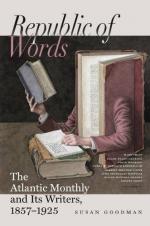The world asks less. It claims to know of a man what the face of him became under the influences of human, temporal relations. It wants preserved of the statesman the statesman’s face, of the merchant the merchant’s face; and this demand, when governed by a cultivated taste, is a legitimate one,—as legitimate as is the demand for any history. The public requires the image of the man whom the public knew, and they regard as valuable that which can be received as a definite and trustworthy statement of a great man, or of one whom it esteemed great. It requires this, has a right to such information; and the generation which fails to demand of its artists a true record of its prominent men fails utterly in its duty. The bust of a man goes down to posterity, not only the history which it is in itself, but as an interpreter of the history of its age. Were it not for Art, an age would recede into the unknown, to be recorded as dark, or into the shadowy world of myth. Portraiture, more than aught else, serves to elucidate the tradition or story of a people. How impossible to explain to the twentieth century the bad mystery of our present, without the aid of Powers’s head of Calhoun, the less adequate bust of Stephen A. Douglas, and the one which should be modelled of Mr. Buchanan! A faithful delineation of the features of some men is needful. We should be thankful for that black frown of Nero, for the bald pate of Scipio, for those queer eyes of Marius, and for the long neck of Cicero, as seen in the newly discovered bust. These are the signs of the men, and explain them.
Mr. Powers has succeeded in reporting more accurately than any other recent artist the physical facts of the individual face. From one of his marbles we derive definite ideas of the human character of its subject, what its ambition is, and what its weakness; what have been its loves and its antipathies, its struggles and its victories, its joys and its sorrows, may be revealed to him who has learned what the human face becomes under the influence of these incessant forces. No mere talent can accomplish such results. Behind all that kind of strength lies the fact of peculiar sympathies, relating the artist to this phase of Art-representation; and within certain limits, which should have been undebatable, his rule was absolute.
The great mistake with Mr. Powers has been his oversight regarding these limits. There has been debate, hesitation, and a continual wandering away from the duties of his errand. Years have been devoted to those ghosts of sculpture, allegorical figures; other years wasted in the elaboration of machinery. Not that his ideal statues are worthless, or fall short of great beauty and exquisite delicacy; not that his skill as a mechanician is other than great. But the age cannot afford these things, nor can the sculptor afford them. A year is too great a sum to give for a statue of California. Better than that, the several portraits of valued men which might have been acquired,—one bust, even, like those which surprised and compelled the reverence of Thorwaldsen. Better the perfected ability which would have given his country the Webster he should and might have made than a hundred “Americas.”




